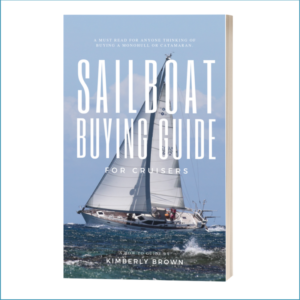Buying a sailboat – how do you ensure that you get it right? What priorities do you need to consider when making the final decision? More on this to come, but let’s take a step back in time. (Note that there’s a video below offering seven critical things to consider when buying a sailboat.)
The first home I lived in during my adult life was small. I moved from America to England to marry my British prince.
My prince, unfortunately, wasn’t the kind that had lots of money.
It was an interesting moment when I discovered that one door leading from the living room went into the kitchen no larger than four square tiles. It was so small you had to shut the door to open the fridge. And it was a miniature fridge with miniature ice cubes in the freezer. How quaint!
And the other door, much to my dismay, did not lead to a second larger living room, a den, or a patio room. The other door led to a closet.
Eventually, my husband, Prince Simon, and I made more money and upgraded to a larger house. Unfortunately, our new house was located next to the railroad tracks. We were told that a service train went through once a day, but otherwise, the track wasn’t used.
The estate agent didn’t tell us that the track was a staging area for all the commuter trains going to and from London every day.
Between 4 am and 5 am every morning, we’d hear loud revving engine noises and have our bedroom filled with diesel exhaust fumes.
We’d often say, ‘When we get our next house, it will be better because we’ll choose one that is larger, that isn’t next to a train track and, and, and…’
When it came to sailboats, we went through a similar process.

We started off renting sailboats for week-long vacations. We’d spend a week in Turkey, Greece, or the British Virgin Islands getting to grips with sailing, living the sailing life, and discovering what we liked and didn’t like about the sailboat we rented.
We’d enjoy our gin and tonics in the cockpit, debating whether maple or beech was the best wood interior. Did we like slab reefing or in-mast furling? Would we want to manage without autopilot? The list went on and on.
We then bit the bullet, buying our first sailboat, a Moody 35’ named Selene.
Selene was a great boat. We purchased her off eBay for a very modest price and considered her our training boat. The ultimate goal was to upgrade and expand our sails to foreign waters eventually.
But in the meantime, we loved how solid Selene was and enjoyed the safety of a center cockpit. Neither Simon nor I, however, enjoyed the lack of standing room. We both had to tilt our heads in all areas of the boat, and getting from the galley to the master cabin required us to crouch down to make the 4’ hallway clearance.
After ten years of chartering over ten different boats and two years of bobbing around the south coast of England on our Moody, we had a nice set of likes and dislikes. When the time came to buy a vessel to house our family for the adventure of a lifetime, we knew what we wanted.
Across our travels, however, we’ve bumped into several sailboat owners who, unfortunately, haven’t had much experience with boats before purchasing.

The results of buying a sailboat that isn’t right, however, can be severely annoying on one end and a full-blown nightmare on the other.
More often than not, we’ve met boat owners who had a dream, purchased the wrong boat, and ended with a nightmare. Some couples we’ve met spent ages buying and fixing a boat up, only to discover they didn’t like to sail.
Other sailboat owners we’ve encountered purchased a sailboat that was too difficult to maneuver, scaring them off sailing forever. Heck, go to any marina in the world during high season and just sit and watch how many boats get taken out of the marina.
You’ll find that most boat owners spend years dreaming, and some eventually get the boat. Unfortunately, however, that is when the dream often ends. For one reason or another, the boat just sits in the marina.
How can you avoid this from happening to you? How can you avoid getting the wrong boat?
Aside from testing out as many boats as possible and purchasing smaller boats working your way up (building confidence and getting experience), you can learn from others who have traveled your path.
Ask as many boat owners as you can about what they like and don’t like about their boat. You’ll be amazed at what you’ll discover. Oftentimes, you’ll find a small golden nugget of information that will help you make a better, more informed decision when you buy your boat.
But before asking too much about boats, please do one thing. Make sure you go sailing. And I’m not talking about taking a class or going out for one of those Catamaran sunset cruises. I can’t tell you how many people we’ve met who actually don’t like sailing and only found out after they purchased the boat!
Sailing is slow, unpredictable, and everything that the modern world is not. It’s not fast-paced. There’s no instant gratification. You often don’t get to where you want to go…but there lies the beauty.
Sailing is often peaceful, calming, natural, and full of all-encompassing bliss.

But it’s not for everyone.
That aside, Simon and I made the video below to discuss seven important things when considering buying a sailboat. There are hundreds of options, and different things are important to some and not others. Like anything in life, we all have our own special set of experiences and preferences.
For us, some key considerations included headroom (being able to stand!).
We also wanted a center cockpit as it’s the safest option for children. Our daughter was 18 months old when we started sailing and 3 ½ years old when we left land permanently. Having the enclosed cockpit more central to the mast and away from the water provided a wider barrier between us and the sea.
Simon and I wanted a heavy ocean-going boat. We wanted a boat that was solid and would slice through the waves rather than be bounced around like a beach ball. The heavier the boat, the more sturdy and smooth she’ll be. And being prone to seasickness, I wanted the smoothest, safest ride possible.
And the number of bedrooms was a factor. We love having friends and family join us on our adventures, so we wanted at least one extra room for a couple and/or family. Our minimum requirement was three rooms with space for others on sofas or the extra bunk bed.
There was no question when it came to the question of Monohull versus Catamaran.
We have always been monohull people, and I suspect we always will be. When planning a trip around the world, we wanted a boat that could weather all situations, and for us, a monohull felt right. There’s no right or wrong in this area – what works best for you, what you feel safest with, and what you want to do with your boat.
Regarding look and feel, both Simon and I have more modern tastes, so we wanted the boat to be light and airy rather than dark and stuffy. We knew boats with deck saloons had big windows allowing light and the lovely breezes.
And finally, the size of the boat had to be big enough to make a home yet small enough for the two of us to handle with ease.
So…four years into our purchase decision and after living aboard non-stop, how do we feel? What do we like, and what don’t we like?
To my surprise, there’s very little we’d change. I’m super thankful we didn’t go any larger. I don’t think we could effectively sail a larger boat, not to mention the larger costs involved.
The one thing that I’d do differently, however, is I’d find a boat that was less power-hungry. We have to run our generator to use our oven, run the watermaker, use air conditioning, wash our clothes, and top up our batteries. Over the years, I’ve gotten better at timing many things simultaneously, and now it’s a routine. I suppose, however, that I’d prefer to be less dependent on a Diesel generator and make more from natural resources like the sun, wind, and water. With ongoing advancements, I’m sure it won’t be long before boats run completely from green energy.
Otherwise, we love Britican. We love what she’s enabled us to do and see. We’re so grateful for our time with her and the times yet to come.
Will there be a next boat for us?
Interestingly, for the first time in my life, I’m not thinking about bigger and better. There are things I’d like to do to help Britican, like update her antiquated electronics and find ways of
What other priorities should you consider?
 In my guide, Sailboat Buying Guide for Cruisers, I offer over 40 other items you might want to consider when choosing the best boat. Best used as a discussion document, this guide will enable the reader to consider options – perhaps some of them hidden.
In my guide, Sailboat Buying Guide for Cruisers, I offer over 40 other items you might want to consider when choosing the best boat. Best used as a discussion document, this guide will enable the reader to consider options – perhaps some of them hidden.
For example, did you know that in the past 30 years, the Atlantic Rally for Cruisers and similar sailing networks have determined that rudder failure is the largest reason for sailboat abandonment? Is rudder construction and configuration high on your list of priorities?
What about the galley layout? Did you know many liveaboard cruisers regret getting a boat with an open-planned galley layout (versus a U-shaped galley or along a corridor)? The reason is that there is nothing to hold onto or lean against when sailing.
In my guide, you’ll get a four-page table listing options to consider, how they may affect you, and a system to prioritize what matters most to you/your partner/your family. Always remember, the more you define what you want, the more chance you’ll get what you want!
Get the guide now – Click here! There’s a full money-back guarantee, so if you feel the guide doesn’t give you many gold nuggets of valuable information, you have nothing to lose.
Should be getting your book Changing Lifestyles pretty soon.Looking forward to a good read. Thanks
Kim, thank you for all of the great info! While we are still about 7 years away, it’s this type of info we are looking for to help us make our journey. Happy Sailing!
Allison & Scott
http://www.boatingjourney.com
Kim,
We installed 450w of Solbian solar onto the bimini last spring, and now have reduced our generator run time down to 45 minutes once every two days, mostly for hot water.
Ken